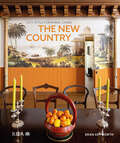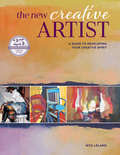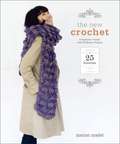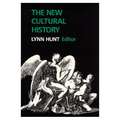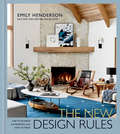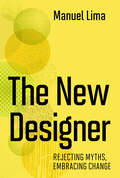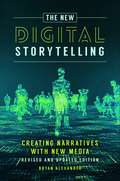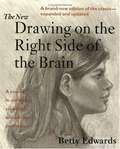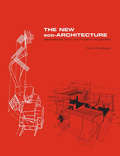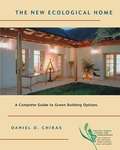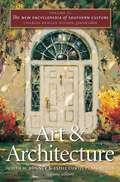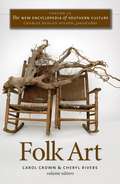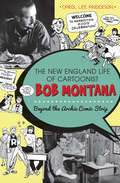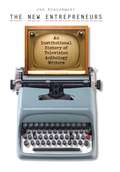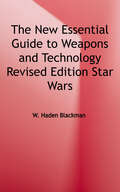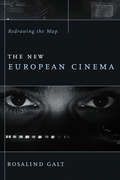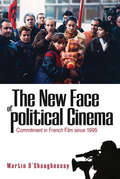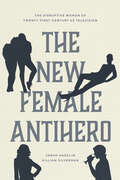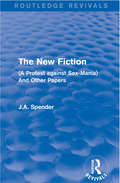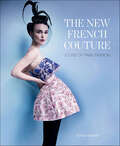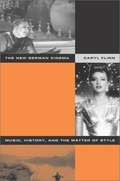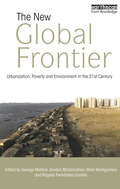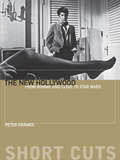- Table View
- List View
The New Country: City style for rural living
by Dean KeyworthYour client has decided to move out of the city to a country property. But they want to create a stylish, urban home in their new rural idyll. As a designer, it can seem difficult to recreate a metropolitan style while working within the more confined parameters of the country. This book shows you how to create a sophisticated scheme while also understanding the practicalities of designing for rural living. This practical and attractive design guide, including inspirational case studies, gives a fresh perspective on designing for country homes, explaining how to integrate contemporary style while engaging with current concerns such as how to design for sustainable building and wellbeing. Individual chapters cover various key rooms around the house with design ideas and practical tips to make them both comfortable and workable, as well as beautiful spaces. The design element of this book explores materials and finishes as well as styling that stand up to country life, the importance of using local materials and crafts people where possible and being aware of the architecture of the house and how it fits with the rural context. Case studies from a variety of exciting interior designers illustrate how following practical guidelines need not result in an uninspiring interior, but can result in an eclectic, contemporary finish.
The New Creative Artist: A Guide to Developing Your Creative Spirit
by Nita LelandOvercome your artist's block and explore what drives you artistically! Artist and teacher Nita Leland shows how to be creative in daily life to develop and strengthen your natural curiosity, flexibility, independence and playfulness--all with the end-goal of creating more inspired, unique personal artwork. Enjoy a variety of fun activities designed to exercise your creative muscle, including how to make an autobiographical collage, creating an idea jar for when you need a random jumpstart, and how to make "dull" subjects more interesting. Learn to push your creative boundaries by trying new methods in dozens of types of media including paper crafts, Japanese brush painting, creative quilting, inventive photography, grown-up finger painting, monotype and more.110+ activities that inspire creativityArtists of all skill levels and mediums can tap into their creativity through exciting techniques and exercisesInspirational tips and advice for taking creative risks to make more meaningful artistic statementsInspiring art from 100 contributing fine artists and crafters in every medium coaching readers to creative success
The New Crochet: A Beginner's Guide, with 38 Modern Projects
by Marion MadelA fresh, upscale approach to crochet, with 38 simple projects presented in 25 comprehensive yet easy-to-understand lessons for anyone just picking up this craft.Crochet gets a chic makeover in this beginner-friendly book from French designer and crochet teacher Marion Madel. The 38 quick and easy projects include oversized scarves, cozy cowls, lacy shawls, decorative embellishments, bags, and much more. In 25 lessons, beginners will steadily build their repetoire of crochet skills, each one presented in detailed step-by-step photos, from creating foundation chains to decreasing and increasting stitches to crocheting in the round. For each lesson, the accompanying patterns offer the chance to try out new stitch patterns and techniques while creating a collection of beautiful garments and accessories that go far beyond typical "beginner's" projects.
The New Cultural History
by Lynn HuntAcross the humanities and the social sciences, disciplinary boundaries have come into question as scholars have acknowledged their common preoccupations with cultural phenomena ranging from rituals and ceremonies to texts and discourse. Literary critics, for example, have turned to history for a deepening of their notion of cultural products; some of them now read historical documents in the same way that they previously read "great" texts. Anthropologists have turned to the history of their own discipline in order to better understand the ways in which disciplinary authority was constructed. As historians have begun to participate in this ferment, they have moved away from their earlier focus on social theoretical models of historical development toward concepts taken from cultural anthropology and literary criticism. Much of the most exciting work in history recently has been affiliated with this wide-ranging effort to write history that is essentially a history of culture. The essays presented here provide an introduction to this movement within the discipline of history. The essays in Part One trace the influence of important models for the new cultural history, models ranging from the path breaking work of the French cultural critic Michel Foucault and the American anthropologist Clifford Geertz to the imaginative efforts of such contemporary historians as Natalie Davis and E. P. Thompson, as well as the more controversial theories of Hayden White and Dominick LaCapra. The essays in Part Two are exemplary of the most challenging and fruitful new work of historians in this genre, with topics as diverse as parades in 19th-century America, 16th-century Spanish texts, English medical writing, and the visual practices implied in Italian Renaissance frescoes. Beneath this diversity, however, it is possible to see the commonalities of the new cultural history as it takes shape. Students, teachers, and general readers interested in the future of history will find these essays stimulating and provocative.
The New Design Rules: How to Decorate and Renovate, from Start to Finish: An Interior Design Book
by Emily Henderson Jessica Cumberbatch AndersonFrom the author of the New York Times bestseller Styled, here is Emily Henderson's masterclass on interior design. &“An approachable guide for anyone who is looking for tools and resources to create a home that speaks to who they are and what they love.&”—Joanna Gaines Whether you&’re embarking on a weekend refresh or complete renovation, interior designer Emily Henderson wants you to take risks with your home design without experiencing regret. In this visually driven decorating bible punctuated with photographs from real homes and colorful illustrations, she takes you through her entire process, including every single decision she makes when it comes to picking paint, arranging furniture, hanging window treatments, and deciding on lighting fixtures. You'll also learn when to hire a contractor versus an architect versus a handyperson, all the materials to consider (and why you might want to skip those marble countertops), proper measurements of the elements in each room, and so much more. By the end of the book, you'll feel more confident when it comes to visualizing the home of your dreams, and you'll finally know how to make it happen.
The New Designer: Rejecting Myths, Embracing Change
by Manuel LimaHow to develop an ethical design practice and build a better world.The choices made by designers have a significant effect on the world. Yet so much of the discourse on design focuses on aesthetics rather than ethics. In The New Designer, acclaimed author Manuel Lima aims to change this by challenging common myths and preconceptions about what comprises good design. He argues that designers must take responsibility for the personal, societal, cultural, and environmental impact of their work, rather than simply following a standard template.As he covers fields ranging from graphic design to industrial design to user-experience design, Lima identifies the major steps that designers must take to be a force for good in the world. Rather than sticking to outmoded ideas about perfectionism and individual genius, designers must work together to tackle some of the most challenging questions of the twenty-first century. How do you make room for humanity, with all its wondrous variations, in a society increasingly driven by metrics, algorithms, and profit? How can ecologically responsible designers consider a product&’s entire life cycle and look well into the future? And how can designers better respond to a community&’s local needs while taking advantage of global networks?Blending approaches derived from ethics, psychology, economics, and ecology, The New Designer is a vital, field-changing treatise that will appeal to any reader who seeks to understand design&’s massive influence on the contemporary world.
The New Digital Storytelling: Creating Narratives With New Media
by Bryan AlexanderWritten for everyone interested in the communication potential of digital media, including educators, marketers, communication professionals, and community activists, this is the ultimate guide to harnessing technology for storytelling. No other book covers the digital storytelling movement as thoroughly as this updated second edition of a popular work, nor does any incorporate as many technologies, from video to augmented reality, mobile devices to virtual reality. <p><p> The book combines history, analysis, and practical guidance about digital storytelling. It begins with a history that encompasses an exploration of storytelling itself, as well as a description of narratives using digital tools from the 1980s through 2000. From there, the author dives into modern digital storytelling, offering analysis and guidance regarding the use of digital video, podcasting, social media, gaming, mobile devices, and virtual and augmented reality. The work concludes with practical advice about how to create and share digital stories using the most current tools so even the new would-be storyteller can create their first digital narrative. <p> Of course, the second edition is updated to take into account the many ways the field has advanced since the original book appeared. With many new examples of digital stories, this edition's evidence base is current and fresh. New or transformed technologies are also addressed, including virtual reality; mobile devices that have become mainstream tools for creating, sharing, and experiencing digital stories; and the wide variety of new storytelling apps and services.
The New Drawing on the Right Side of the Brain (Revised and Expanded Third Edition)
by Betty EdwardsTranslated into thirteen languages, Drawing on the Right Side of the Brain is the world's most widely used drawing-instruction guide. People from just about every walk of life--artists, students, corporate executives, architects, real estate agents, designers, engineers--have applied its revolutionary approach to problem solving.
The New Eco-Architecture: Alternatives from the Modern Movement
by Colin PorteousThe New Eco-Architecture builds a historical bridge between architectural science and design. It seeks to address neglected aspects of the Modern Movement as a prelude to supporting a diversity of architectural insight and experimentation aimed at twenty-first century environmental needs and priorities. The attitudes and influences of renowned figures are re-examined in relation to current issues of architectural sustainability.By setting today's green architectural quest within a twentieth century context, and evaluating the main protagonists with regard to a modern eco-sensitive lineage, the book will be of primary interest to architectural students, academics and practitioners. However, it should also intrigue historians, theoreticians and critics, who tend to gloss over such issues, as well as other disciplines engaged with the built environment.
The New Ecological Home
by Daniel D. ChirasToday, a new generation of architects and builders is emerging, intent on creating homes that meet human needs for shelter while causing only a fraction of the environmental impact of conventional housing. "The New Ecological Home" provides an overview of green building techniques, materials, products, and technologies that are either currently available or will be in the near future. Author Daniel Chiras provides a wealth of up-to-date, practical information for home buyers, owner-builders, and anyone interested in building for a sustainable future. Included are chapters on: - The Healthy House - Green Building Materials - Wood-Wise Construction - Energy Efficiency - Earth-Sheltered Architecture - Passive Solar Heating and Passive Cooling - Green Power: Electricity from the Sun and Wind - Water and Waste: Sustainable Approaches - Environmental Landscaping
The New Encyclopedia of Southern Culture: Art and Architecture
by Charles Reagan Wilson Estill Curtis Pennington Judith H. BonnerFrom the Potomac to the Gulf, artists were creating in the South even before it was recognized as a region. The South has contributed to America's cultural heritage with works as diverse as Benjamin Henry Latrobe's architectural plans for the nation's Capitol, the wares of the Newcomb Pottery, and Richard Clague's tonalist Louisiana bayou scenes. This comprehensive volume shows how, through the decades and centuries, the art of the South expanded from mimetic portraiture to sophisticated responses to national and international movements. The essays treat historic and current trends in the visual arts and architecture, major collections and institutions, and biographies of artists themselves. As leading experts on the region's artists and their work, editors Judith H. Bonner and Estill Curtis Pennington frame the volume's contributions with insightful overview essays on the visual arts and architecture in the American South.
The New Encyclopedia of Southern Culture: Folk Art
by Charles Reagan Wilson Carol Crown Cheryl RiversFolk art is one of the American South's most significant areas of creative achievement, and this comprehensive yet accessible reference details that achievement from the sixteenth century through the present. This volume of The New Encyclopedia of Southern Culture explores the many forms of aesthetic expression that have characterized southern folk art, including the work of self-taught artists, as well as the South's complex relationship to national patterns of folk art collecting. Fifty-two thematic essays examine subjects ranging from colonial portraiture, Moravian material culture, and southern folk pottery to the South's rich quilt-making traditions, memory painting, and African American vernacular art, and 211 topical essays include profiles of major folk and self-taught artists in the region.
The New England Life of Cartoonist Bob Montana: Beyond the Archie Comic Strip
by Carol Lee AndersonThe true story of the artist whose high school years in Massachusetts inspired Riverdale. Bob Montana, creator of the Archie comic strip and one of America&’s greatest cartoonists, always considered himself a true New Englander. Filled with the antics of the rambunctious teenagers of the fictional Riverdale High, Montana&’s comic strip was based on his high school years in Haverhill, Massachusetts. At the height of his career, he lived as a beloved resident in the quaint, picturesque town of Meredith in the heart of the Lakes Region of New Hampshire. For nearly thirty years, he was considered an extraordinarily respected contributor to the community. Drawing from the Yankee humor he saw around him, Montana deftly included local scenes, events, and characters in the puns and pranks of Archie&’s comic-strip life. Join Lakes Region historian Carol Lee Anderson as she takes readers beyond the comic strip and tells the story of the remarkable New England life of Bob Montana.
The New Entrepreneurs
by Jon KraszewskiAccording to the sociologist C. Wright Mills in his 1951 book, White Collar: The American Middle Classes, the "new entrepreneur" was a lone wolf able to succeed in post-World War II corporate America by elusively meandering through various institutions. During this time, anthology writers such as Rod Serling, Reginald Rose, and Paddy Chayefsky achieved a level of creativity that has rarely been equaled on television since. Yet despite their success, anthology writers still needed to evade the constraints and censorship of 50s television in order to stay true to their creative powers and political visions. Thus they worked as new entrepreneurs who adapted their more controversial scripts for the Hollywood, Broadway, and book publishing industries. Even after the television networks cancelled their prestigious anthology series at the end of the 50s, the most resilient writers were able to redefine what it meant to be entrepreneurs by launching cutting-edge shows such as The Twilight Zone and The Defenders that are still popular today. The New Entrepreneurs includes detailed textual analysis of legendary, sometimes hard-to-find, television anthology scripts that have received only cursory glances in television history until now.
The New Essential Guide to Weapons and Technology Revised Edition Star Wars
by W. Haden BlackmanFrom the Geonosian sonic blaster to the Wookiee bowcaster; from the Imperial energy grenade to the Yuuzhan Vong fire spitter; from dart shooters and laser cannons to Sun Crushers and World Devastators, find the facts about Star Wars firepower--and much more--in The New Essential Guide to Weapons + Technology. There's more to the arms, artillery, and exotic equipment of the Star Wars galaxy than Jedi lightsabers and blasters. Species such as the tree-dwelling Wookiees, the amphibious Gungans, and the deadly Yuuzhan Vong have yielded a staggering array of unique weapons and devices. And as the Star Wars mythos continues to grow--in prequels and video games, on screen, in print, and beyond--these remarkable technical creations also multiply and evolve. The New Essential Guide to Weapons + Technology is the fully updated and greatly expanded reference resource that organizes and explains every key class, make, and model of Star Wars munitions--from the smallest personal sidearms to the most devastating interplanetary superweapons--along with a host of other high-tech paraphernalia. This exhaustive compendium includes:- New in this edition: A fascinating look at the historical significance of Star Wars weaponry and the major technological turning points--including the Clone Wars, the creation of the first Death Star, and the Yuuzhan Vong invasion - A roster of the major manufacturers who created the most powerful armaments for the Old and New Republics, the Empire, the Sith, the Rebel Alliance, andall of the exotic governments that populate the Star Wars galaxy - In-depth descriptions of more than 100 weapons and more than 100 additional devices used for defense, communication, survival, and security--including key technology featured in the films
The New European Cinema: Redrawing the Map (Film and Culture Series)
by Rosalind GaltNew European Cinema offers a compelling response to the changing cultural shapes of Europe, charting political, aesthetic, and historical developments through innovative readings of some of the most popular and influential European films of the 1990s. Made around the time of the revolutions of 1989 but set in post-World War II Europe, these films grapple with the reunification of Germany, the disintegration of the Balkans, and a growing sense of historical loss and disenchantment felt across the continent. They represent a period in which national borders became blurred and the events of the mid-twentieth-century began to be reinterpreted from a multinational European perspective.Featuring in-depth case studies of films from Italy, Germany, eastern Europe, and Scandinavia, Rosalind Galt reassesses the role that nostalgia, melodrama, and spectacle play in staging history. She analyzes Giuseppe Tornatore's Cinema Paradiso, Michael Radford's Il Postino, Gabriele Salvatores's Mediterraneo, Emir Kusturica's Underground, and Lars von Trier's Zentropa, and contrasts them with films of the immediate postwar era, including the neorealist films of Roberto Rossellini and Vittorio De Sica, socialist realist cinema in Yugoslavia, Billy Wilder's A Foreign Affair, and Carol Reed's The Third Man. Going beyond the conventional focus on national cinemas and heritage, Galt's transnational approach provides an account of how post-Berlin Wall European cinema inventively rethought the identities, ideologies, image, and popular memory of the continent. By connecting these films to political and philosophical debates on the future of Europe, as well as to contemporary critical and cultural theories, Galt redraws the map of European cinema.
The New Face Of Political Cinema
by Martin OashaughnessySince 1995 there has been a widespread return of commitment to French cinema taking it to a level unmatched since the heady days following 1968. But this new wave of political film is very different and urgently calls out for an analysis that will account for its development, its formal characteristics and its originality. This is what this book provides. It engages with leading directors such as Cantet, Tavernier, Dumont, Kassovitz, Zonca and Guédiguian, takes in a range of less well known but important figures and strays across the Belgian border to engage with the seminal work of the Dardenne brothers. It shows how the works discussed are helping to reinvent political cinema by finding stylistic and narrative strategies adequate to the contemporary context.
The New Female Antihero: The Disruptive Women of Twenty-First-Century US Television
by Gillian Silverman Sarah HagelinThe New Female Antihero examines the hard-edged spies, ruthless queens, and entitled slackers of twenty-first-century television. The last ten years have seen a shift in television storytelling toward increasingly complex storylines and characters. In this study, Sarah Hagelin and Gillian Silverman zoom in on a key figure in this transformation: the archetype of the female antihero. Far from the sunny, sincere, plucky persona once demanded of female characters, the new female antihero is often selfish and deeply unlikeable. In this entertaining and insightful study, Hagelin and Silverman explore the meanings of this profound change in the role of women characters. In the dramas of the new millennium, they show, the female antihero is ambitious, conniving, even murderous; in comedies, she is self-centered, self-sabotaging, and anti-aspirational. Across genres, these female protagonists eschew the part of good girl or role model. In their rejection of social responsibility, female antiheroes thus represent a more profound threat to the status quo than do their male counterparts. From the devious schemers of Game of Thrones, The Americans, Scandal, and Homeland, to the joyful failures of Girls, Broad City, Insecure, and SMILF, female antiheroes register a deep ambivalence about the promises of liberal feminism. They push back against the myth of the modern-day super-woman—she who “has it all”—and in so doing, they give us new ways of imagining women’s lives in contemporary America.
The New Female Antihero: The Disruptive Women of Twenty-First-Century US Television
by Gillian Silverman Sarah HagelinThe New Female Antihero examines the hard-edged spies, ruthless queens, and entitled slackers of twenty-first-century television. The last ten years have seen a shift in television storytelling toward increasingly complex storylines and characters. In this study, Sarah Hagelin and Gillian Silverman zoom in on a key figure in this transformation: the archetype of the female antihero. Far from the sunny, sincere, plucky persona once demanded of female characters, the new female antihero is often selfish and deeply unlikeable. In this entertaining and insightful study, Hagelin and Silverman explore the meanings of this profound change in the role of women characters. In the dramas of the new millennium, they show, the female antihero is ambitious, conniving, even murderous; in comedies, she is self-centered, self-sabotaging, and anti-aspirational. Across genres, these female protagonists eschew the part of good girl or role model. In their rejection of social responsibility, female antiheroes thus represent a more profound threat to the status quo than do their male counterparts. From the devious schemers of Game of Thrones, The Americans, Scandal, and Homeland, to the joyful failures of Girls, Broad City, Insecure, and SMILF, female antiheroes register a deep ambivalence about the promises of liberal feminism. They push back against the myth of the modern-day super-woman—she who “has it all”—and in so doing, they give us new ways of imagining women’s lives in contemporary America.
The New Female Antihero: The Disruptive Women of Twenty-First-Century US Television
by Gillian Silverman Sarah HagelinThe New Female Antihero examines the hard-edged spies, ruthless queens, and entitled slackers of twenty-first-century television. The last ten years have seen a shift in television storytelling toward increasingly complex storylines and characters. In this study, Sarah Hagelin and Gillian Silverman zoom in on a key figure in this transformation: the archetype of the female antihero. Far from the sunny, sincere, plucky persona once demanded of female characters, the new female antihero is often selfish and deeply unlikeable. In this entertaining and insightful study, Hagelin and Silverman explore the meanings of this profound change in the role of women characters. In the dramas of the new millennium, they show, the female antihero is ambitious, conniving, even murderous; in comedies, she is self-centered, self-sabotaging, and anti-aspirational. Across genres, these female protagonists eschew the part of good girl or role model. In their rejection of social responsibility, female antiheroes thus represent a more profound threat to the status quo than do their male counterparts. From the devious schemers of Game of Thrones, The Americans, Scandal, and Homeland, to the joyful failures of Girls, Broad City, Insecure, and SMILF, female antiheroes register a deep ambivalence about the promises of liberal feminism. They push back against the myth of the modern-day super-woman—she who “has it all”—and in so doing, they give us new ways of imagining women’s lives in contemporary America.
The New Fiction: (A Protest against Sex-Mania) And Other Papers (Routledge Revivals)
by J.A. SpenderThis collection of essays attempts to analyse common assumptions about art, literature and criticism at the time of publication in 1895. Taking the position of ‘a Philistine’ , Spender argues against the ‘new’ art and fiction and encourages the average member of the public to state their opinion and give validation that the average view is just as worthy as the ‘new’ criticism which tended toward superiority. This title will be of interest to students of Literature, Art and Art History.
The New French Couture: Icons of Paris Fashion
by Elyssa DimantA gorgeous, groundbreaking survey of the evolution of the world’s renowned French ateliers, from the vision of their founding designers to those today who both preserve the signature iconographies and bring their own interpretations to bear on modern couture fashion.The world awaits Paris’s flawless fashion presentations year after year, just as the evolutionary arc of French fashion grows richer with each season and each new talent. The New French Couture identifies those fashion leaders whose long-standing ateliers have persevered, and whose current creative pioneers continue to reinvent the signature iconographies upon which each house was founded. Saint Laurent, Dior, Chanel, Lanvin, Givenchy, Hermès, Louis Vuitton, and Balenciaga have all made undeniable contributions to fashion, both historically and today, through their distinct and potent visions.With more than two hundred images by fashion’s top photographers, this beautifully designed volume provides an exclusive tour through the evolutions of these eight ateliers, revealing each brand via an encapsulated history of definitive looks and fashion moments. Fashion icon and blogger Leandra Medine contributes to an exposition that highlights designers who have carved out new visions for French luxury in the contemporary era, including Christian Lacroix, Jean Paul Gaultier, Céline, Rick Owens, Alexander McQueen, Hussein Chalayan, Azzedine Alaïa, Comme des Garçons, and Yohji Yamamoto, among others. The New French Couture is a comprehensive survey of the revolutionary creative talents who are bringing their genius to bear on the City of Light today via the ateliers that have defined and defended fashion for nearly a century.
The New German Cinema: Music, History, and the Matter of Style
by Caryl FlinnWhen New German cinema directors like R. W. Fassbinder, Ulrike Ottinger, and Werner Schroeter explored issues of identity--national, political, personal, and sexual--music and film style played crucial roles. Most studies of the celebrated film movement, however, have sidestepped the role of music, a curious oversight given its importance to German culture and nation formation. Caryl Flinn's study reverses this trend, identifying styles of historical remembrance in which music participates. Flinn concentrates on those styles that urge listeners to interact with difference--including that embodied in Germany's difficult history--rather than to "master" or "get past" it. Flinn breaks new ground by considering contemporary reception frameworks of the New German Cinema, a generation after its end. She discusses transnational, cultural, and historical contexts as well as the sexual, ethnic, national, and historical diversity of audiences. Through detailed case studies, she shows how music helps filmgoers engage with a range of historical subjects and experiences. Each chapter ofThe New German Cinemaexamines a particular stylistic strategy, assessing music's role in each. The study also examines queer strategies like kitsch and camp and explores the movement's charged construction of human bodies on which issues of ruination, survival, memory, and pleasure are played out.
The New Global Frontier: Urbanization, Poverty and Environment in the 21st Century
by George Martine Mark Montgomery Gordon McGranahan Rogelio FernThe worlds developing countries will be experiencing massive increases in their urban populations over the 21st century. If managed intelligently and humanely, this growth can pave the way to sustainable development; otherwise, it will favour higher levels of poverty and environmental stress. The outcome depends on decisions being made now. The principal theme that runs through this volume is the need to transform urbanization into a positive force for development. Part I of this book reviews the demography of the urban transition, stressing the importance of benefi cial rural-urban connections and challenging commonly held misconceptions. Part II asks how urban housing, land and service provision can be improved in the face of rapid urban expansion, drawing lessons from experiences around the world. Part III analyses the challenges and opportunities that urbanization presents for improving living environments and reducing pressures on local and global ecosystems. These social and environmental challenges must be met in the context of fast-changing demographic circumstances; Part IV explores the range of opportunities that these transformations represent. These challenges and opportunities vary greatly across Africa, Asia and Latin America, as detailed in Part V. Published with IIED and UNFPA
The New Hollywood
by Peter KramerOn December 8, 1967 Time magazine put Bonnie and Clyde on its cover and announced, "The New Cinema: Violence ... Sex ... Art." The following decade has long been celebrated as a golden age in American film history. In this innovative study, Peter Krämer offers a systematic discussion of the biggest hits of the period (including The Graduate [1967], The Exorcist [1973] and Jaws [1975]). He relates the distinctive features of these hits to changes in the film industry, in its audiences and in American society at large.
